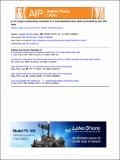P- to n-type conductivity transition in 1.0 eV GaInNAs solar cells controlled by the V/III ratio
Date
09/02/2015Metadata
Show full item recordAbstract
In this work, we report a p- to n-type conductivity transition of GaInNAs (1.0 eV bandgap) layers in p-i-n dilute nitride solar cells continuously controlled by the V/III ratio during growth. Near the transition region, we were able to produce GaInNAs layers with very low effective electrically active doping concentrations resulting in wide depleted areas. We obtained internal quantum efficiencies (IQEs) up to 85% at 0.2 eV above the bandgap. However, the high IQE comes along with an increased dark current density resulting in a decreased open circuit voltage of about 0.2 V. This indicates the formation of non-radiant defect centers related to the p-type to n-type transition. Rapid-thermal annealing of the solar cells on the one hand helps to anneal some of these defects but on the other hand increases the effective doping concentrations.
Citation
Langer , F , Perl , S , Höfling , S & Kamp , M 2015 , ' P- to n-type conductivity transition in 1.0 eV GaInNAs solar cells controlled by the V/III ratio ' , Applied Physics Letters , vol. 106 , no. 6 , 063905 . https://doi.org/10.1063/1.4909507
Publication
Applied Physics Letters
Status
Peer reviewed
ISSN
0003-6951Type
Journal article
Collections
Items in the St Andrews Research Repository are protected by copyright, with all rights reserved, unless otherwise indicated.

